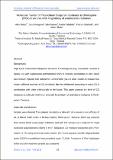| dc.contributor.author | Shayo, Alex | |
| dc.contributor.author | Ishengoma, Deus | |
| dc.contributor.author | Baraka, Vito | |
| dc.contributor.author | Madebe, Rashid | |
| dc.contributor.author | Shahada, Francis | |
| dc.contributor.author | Buza, Joram | |
| dc.date.accessioned | 2019-10-10T12:15:29Z | |
| dc.date.available | 2019-10-10T12:15:29Z | |
| dc.date.issued | 2014 | |
| dc.identifier.issn | 2325-4076 | |
| dc.identifier.uri | http://dspace.nm-aist.ac.tz/handle/123456789/482 | |
| dc.description | Research Article published by American Journal of Research Communication Vol 2(11) | en_US |
| dc.description.abstract | Background
High levels Plasmodium falciparum resistance to Chloroquine (CQ) compelled Tanzania to replace CQ with Suphadoxine-pyrimethamine (SP) as first-line antimalarial in 2001 which was however replaced with Artemether Lumefantrine (AL) in 2006. Studies in Malawi have shown sufficient recovery of CQ-sensitivity after its withdrawal warranting re-using CQ in combination with other antimalarials in the future. This paper assessed the level of CQ resistance at molecular level in an area with long history of antimalarial resistance in North-eastern Tanzania.
Materials and Methods
Samples were obtained from patients recruited in a clinical trial to assess in vivo efficacy of AL at Mkuzi health centre in Muheza district, North-eastern Tanzania. DNA was extracted from venous blood using Qiagen extraction midi kit. The samples were analyzed for single nucleotide polymorphisms (SNPs) in the P. falciparum CQ resistance transporter gene (Pfcrt; codons 72–76) using polymerase chain reaction (PCR) and sequence-specific oligonucleotide probe (SSOP) enzymelinked immunosorbent assay (ELISA). Prevalence of Pfcrt haplotypes before and after treatment samples was compared.
Results
A total of 104 microscopically positive samples were genotyped for the Pfcrt haplotypes. Of these, 78 (75%) samples contained wild-type (CVMNK) haplotype, 21 (20.2%) contained resistant (CVIET) haplotype while 5 (4.8%) samples had mixed (CVMNK/CVIET) infections. There were no SVMNT haplotype among the samples. The prevalence of the Pfcrt wild-type CVMNK haplotype was high in the study area reaching over 76%. No significant selection of the Pfcrt wild-type CVMNK haplotype after treatment with AL was observed (p ˃ 0.05).
Conclusions
Compared to the previous studies in the study area, the prevalence of CQ sensitive parasites has increased in the study area. However the rate of sensitivity restoration in this study site with long history of antimalarial drug resistance was slower than rates reported from other parts of Tanzania. These findings suggest complete CQ sensitivity restoration and hence re-introduction of CQ (e.g. in a drug combination) in the study area will most likely take longer than previously anticipated. | en_US |
| dc.language.iso | en | en_US |
| dc.publisher | American Journal of Research Communication | en_US |
| dc.subject | Plasmodium falciparum | en_US |
| dc.subject | CVMNK-haplotype | en_US |
| dc.subject | CIVIET-haplotype | en_US |
| dc.subject | Drug resistance | en_US |
| dc.title | Molecular marker of Plasmodium falciparum resistance to chloroquine (Pfcrt) in an area with long history of antimalarial resistance | en_US |
| dc.type | Article | en_US |

